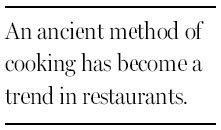Chefs return wood to the cooking fire
Updated: 2013-06-16 07:41
By Rachel Wharton(The New York Times)
|
|||||||
|
Dan Barber of Blue Hill at Stone Barns near New York City cooking cabbage and asparagus with pork bone charcoal. Chang W. Lee / The New York Times |

When Matthew Semmelhack and Mark Liberman, the owners of AQ in San Francisco, open their new restaurant nearby later this year, they won't have a stove. Or an oven.
Instead, the kitchen at TBD, as it will be known, will be dominated by a two-and-a-half-meter-wide stainless steel wood-fired grill, outfitted with custom-built nooks, fire cages for coal production and four independent cooking surfaces that Mr. Liberman, the chef, can easily raise and lower with hand-cranked wheels.
Nearly everything he turns out - smoked fluke crudo, say, or maybe spit-roasted Cornish hens and charred endive glazed with orange and burned sugar - will be cooked on this sole piece of equipment, eliminating the relative predictability of appliances that ignite with the turn of a dial and provide consistent heat.
"Some people say it's limiting," Mr. Semmelhack said. "But we think it's freeing."
Forget the barbecue pits and tiled pizza ovens popping up everywhere - wood-fired grills are poised to become the new face of flame. A growing number of chefs are using them to elevate wood cookery to new heights, making food that is light-years from barbecue.
Some, like Seamus Mullen of Tertulia, in the West Village in New York, even say they have come to see the grills as integral to their cooking. The smoke of the grill there, he said, is "the signature, distinctive flavor of the restaurant." About 90 percent of the dishes on his menu include elements cooked on Tertulia's green-tiled grill, which is also used as an oven, a broiler, a smoker and a flat-top griddle.
Unlike a traditional grill, which has a grate set directly over a fire, these versions are designed to give chefs far more flexibility and more control over what's happening to their food.
Some grills are enclosed on the three sides, lined with brick or tiled walls that retain heat. In addition to more straightforward grilling, you could roast and bake using the wall's ambient heat, sear over the bottom fire, or cold smoke high above.
The cost of installing one is comparable to that of conventional equipment; Mr. Semmelhack said that going with a grill saved them the cost of running a gas line into the TBD kitchen, an expensive proposition.
Ben Eisendrath, the owner of Grillworks, a United States manufacturer of hand-built stainless steel grills that have become a favorite among chefs, said that is the fastest-growing segment of his business.
The chefs who have taken to doing so much of their cooking on the grill aren't discovering something new so much as exploring the ancient. Wood-fired cooking, after all, is the oldest kind there is, and Spaniards and South Americans have been using similar, albeit more rustic, grills for centuries.
Chefs are able to make wood cookery feel fresh by incorporating smoke into their food with a subtle hand. They are also constantly exploring new uses for the grill. The Spanish chef Victor Arguinzoniz has been hugely influential in this respect, drawing visitors from all over the world to his restaurant in the Basque region of Spain, Asador Etxebarri, where everything (caviar, smoked goat-milk ice cream) is either cooked directly on a big-wheeled grill or touched by smoke or flame.
At Blue Hill at Stone Barns in Pocantico Hills, New York, Dan Barber uses his free-standing, three-and-a-half meter custom grill, on the patio, to build flavor or apply heat in ways he can't in his traditional kitchen.
At Reynard in Brooklyn, Sean Rembold's all-day menu is laced with the scent of oak and applewood, starting with wood-fired toast at breakfast.
He hopes his grill will help attract top talent, luring a slew of skilled staff members ready to hone their technique in the 427-degree heat. But, he admitted, it might come with its own set of workplace issues. Anyone who works at Reynard, Mr. Rembold said, has to be ready to "slowly roast themselves over a 12-hour shift."
The New York Times
(China Daily 06/16/2013 page10)
